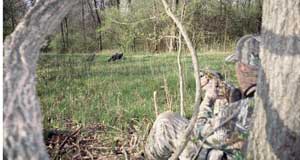
Hung-up gobblers are so common in turkey hunting as to be cliches. Discover some experts’ tactics to draw them closer.
“The only certainty in turkey hunting is uncertainty,” Parker Whedon once said.
He ought to know.
Whedon has spent portions of seven decades successfully chasing longbeards, knows the literature of the sport intimately, is a nationally-recognized call-maker and during his early years in the sport, corresponded with icons such as Inman Turpin and Henry Edwards Davis.
While Whedon lives in North Carolina, a great deal of his hunting experience has centered on the Palmetto State. That explains, in part at least, his link with Davis, who resided in Florence and is widely recognized as the author of the finest book, “The American Wild Turkey,” ever written about the sport.
With his years of accumulated wisdom and countless hours afield, Whedon has learned sometimes standard “sit-down-and-call-him-in” approaches don’t work.
“You do what you need to,” he said, “and often that involves employing offbeat tactics.”
Another nationally-known hunter who has spent considerable time chasing toms in South Carolina, Mark Drury, takes a similar view of matters.
The founder of M.A.D. Calls, a former contest caller recognized as one of the nation’s best in the early 1990s, and the producer of widely acclaim videos about turkey hunting, Drury averages 60 hunting days in at least half a dozen states every year. He is also profiled, along with Brad Harris, in the book “Innovative Turkey Hunting.”
Drury’s view of tactics for dealing with toms is at once straightforward and complex.
“You read the gobbler’s book,” he said, “then try to figure out what will work when it comes to getting him within gun range. Sometimes decidedly unorthodox techniques provide an answer when you have tried standard approaches to no avail.”
With those thoughts from two experts in mind, let’s look at some techniques that stray well off the beaten path of turkey-hunting wisdom. They shouldn’t be viewed as your standard stock in trade, but rather consider them as a series of aces in the hole you might want to draw when playing the standard turkey-hunting cards doesn’t work.
The sounds of silence
Many modern hunters seem to be enthralled with the sounds of their own voices.
Venture afield with a young hot shot, perhaps someone who has placed in a local calling contest or two, and invariably you’ll wish you had ear plugs. They invariable call almost incessantly. Somehow they fail to realize that for the vast majority of each day, turkeys are silent.
Almost never does one encounter a hen that yelps and cuts constantly. Moreover, turkeys don’t become consummate survivors through blissfully ignoring things that seem out of step and out of tune with the world around them.
Calling too much, too loud, and too long sends them a clear message to the effect “something’s wrong; it would be best to avoid the area.”
Old-timers never made such mistakes. They called sparingly and softly, with the cluck being their favorite call. When they yelped, it was a short, subdues series of only four or five yelps. Similarly, they had little truck with cutting, fly-down cackles, and the like.
“Get his attention and lay a heavy dose of silence on him,” Whedon said.
Or, to put it another way, bring patience — an increasingly rare quality in today’s turkey hunting world — into the equation in a big way.
Click here to read the rest of this story, which first appeared in the April 2006 issue of South Carolina Sportsman magazine. Subscribe to ensure you don’t miss a single information-packed issue.



Be the first to comment